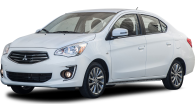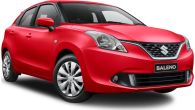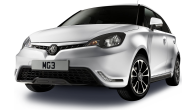Tim Robson road tests and reviews the new Hyundai Ioniq Hybrid four-door with specs, fuel consumption and verdict at its international launch in Korea.
To be truthful, hybrid vehicles haven't really caught on in Australia, with just 11,000-odd of the 1.15 million vehicles sold here in 2016 being classified as a hybrid.
There are a few reasons – they are, dollar for dollar, dearer than their regular siblings, there's a perception that they may be more expensive to service down the track (batteries in particular are a concern), and our government doesn't offer any form of incentive for people switching away from petrol or diesel cars, unlike other countries.
However, as governments around the world (well, most governments, anyway) continue to ramp up the pressure on carbon emitters, solutions to reduce outputs will become even more crucial to car companies, who are obliged to cut more and more pollutants across their respective fleets.
Hyundai is certainly not taking a backwards step when it comes to experimenting with alternative fuel vehicles. Not only is it a strong proponent of hydrogen fuel cell tech, it's also exploring the area of electrification and hybridisation... which has led us to Seoul, Korea, to try out Hyundai's self-proclaimed Toyota Prius fighter, the Ioniq.
It's being built in three forms - petrol/electric hybrid, a plug-in version of the same, and a fully electric version, all under the same fastback skin. Does the Ioniq have what it takes to take the interest in hybrids to the next level?
Is there anything interesting about its design?
Hyundai's brief with the Ioniq was to keep it looking and behaving as 'normal' as possible, and it's certainly nailed it on the appearance side. It's wrong to call the Ioniq plain, but it certainly eschews most of the overt design language that sets cars like the Prius – quite deliberately – apart from the pack.
In fact, aside from a hint of 'hybrid' blue across the nose and a stylised rear end, the Ioniq is all but indistinguishable from a regular fastback sedan.
The Ioniq defies convention by looking like... well, a regular car.
The 17-inch rims also stop short of looking like concept car specials, though astute car spotters will pick the different style of LED driving lamps.
It's actually both lower and longer than the fourth generation Prius, while a grille-mounted aero flap and a flat underfloor lowers the Ioniq's drag coefficient to 0.24; the same as the Prius.
How practical is the space inside?
Again, the Ioniq defies convention by looking like... well, a regular car. While companies like BMW and Mercedes-Benz produce plug-in hybrids that don't stray too far from the donor car's DNA, others are guilty of producing an interior that could have escaped from the set of The Jetsons, with a multitude of buttons and screens that only serve to confound (the Holden Volt was a prime example of a good car spoiled by a generation one iPod-esque interior).
If anything, the Ioniq is perhaps a bit underdone when it comes to interior design, especially after hopping out of the new i30. All the controls are normal, including the gear shifter, while the dash adds only a battery charge gauge to its regular controls. There are really no buttons to push (aside from seat warmers and coolers), and very little to get in the way of driving the car.
Front seat room is ample, with low-slung seats and plenty of headroom, though things are a little tighter in the back. The outside rears are quite sizeable, but the centre squab is very narrow. A pull-down armrest hides two cupholders, and the plastic rear covers of the front seats are sculpted for more knee room.
ISOFIX baby seat mounts are present on both rear seat positions, while there are bottle holders in all of the doors, a pair of cupholders up front and a pair in the rear. The back seaters miss out on air vents and power points, though.
The cargo area, however, is a real winner, with the large tailgate revealing 443 litres of load area, which grows to 1505 with the seats down.
Does it represent good value for the price? What features does it come with?
Hyundai Australia is keen as mustard to bring the plug-in hybrid to Australia, but it's not likely to happen until next year. The theory is that to stay ahead of the competition, it needs to go one up in the technology stakes, and offering a plug-in with 50km of range will trump the Prius very comfortably.
The hybrid we tested in Korea was well equipped with heated and cooled leather-trimmed seats (though they were manual in operation to save weight), a touchscreen multimedia system, auto lights and wipers and a full range of safety electronics including auto emergency braking and radar cruise control.
What are the key stats for the engine and transmission?
The Ioniq runs a 77kW naturally aspirated Atkinson cycle version of the company's 1.6-litre petrol four-cylinder engine, combined with a 32kW electric motor sitting just in front of the Ioniq's six-speed dual clutch auto transmission. Together, they produce 103kW and 265Nm.
Right away, this spec sets it apart from the Prius, which uses an Atkinson cycle 1.8-litre petrol engine and a continuously variable transmission for just 90kW of combined power with its electric engine.
The Ioniq hybrid can run for a few kilometres on battery power at up to 40km/h, but the plug-in version increases that range to 50km at speeds of up to 140km/h.
Hyundai also uses lithium ion batteries from fellow Korean company LG for the Ioniq, claiming they are more efficient and longer lasting than more conventional nickel-metal hydride units.
How much fuel does it consume?
Hyundai claims a figure of 3.4 litres per 100km on the combined fuel economy cycle for the hybrid Ioniq. A 120km stint in the car netted a figure closer to 5.0L/100km – which is still pretty good!
What's it like to drive?
A regular gearbox and decent petrol engine sets the Ioniq apart from its competitors, and is a big part of making the car feel absolutely indistinguishable from a non-hybrid car.
Even the regenerative braking effect – used to charge the batteries by turning the electric motor into a generator while you're off the accelerator – is minimal.
The transition between the electric and petrol engine is all but transparent, too, with the electric engine taking up some of the slack of the naturally aspirated engine from a standstill. All-electric mode comes into play in shopping centre carparks and the like, but for the most part, the petrol engine provides most of the propulsion.
In isolation, though, the Ioniq is a neutral, faithful car to drive with no quirks to speak of.
Hyundai went to great lengths to keep weight out of the Ioniq, fitting an aluminium bonnet and tailgate to save upwards of 12kg.
Based on the same strut front/multi-link rear set up as the Elantra and new i30, the Ioniq isn't quite as refined as the i30, with a slightly less precise, less sophisticated handling tune.
In isolation, though, the Ioniq is a neutral, faithful car to drive with no quirks to speak of – and the team at Hyundai Australia will definitely sharpen it up dynamically before it lobs down under.
What safety equipment is fitted? What safety rating?
The Ioniq boasts a full suite of safety software, including AEB, radar cruise control, rear traffic alert and lane departure guidance, as well as seven airbags.
What does it cost to own? What warranty is offered?
It's still some time before the Ioniq lobs down under, so running costs and warranties are yet to be worked out. Expect the company's five year/unlimited kilometre warranty to apply, though.
It's worth noting Hyundai offers a lifetime warranty on the Ioniq's battery array in overseas markets.
Hyundai Ioniq 2017: Electric Elite (Black Grille)
| Engine Type | Not Applicable, 0.0L |
|---|---|
| Fuel Type | Electric |
| Fuel Efficiency | 0.0L/100km (combined) |
| Seating | 5 |
| Price From | $13,750 - $18,040 |
| Safety Rating |
|
Verdict
Hybrids are a tough sell at the moment. Even if Hyundai manages to bring the plug-in version in for less than $40,000, it's competing against cars that cost up to $10,000 less that have comparable fuel economy – including its own i30 diesel.
The future is coming, though, and Hyundai understands that one of the hurdles preventing people switching to alternative cars is a fear of the unknown. The Ioniq is designed to behave just like a normal car, and it happens to emit a lot less carbon into the atmosphere.
If and when governments mandate tougher emissions rules, the Ioniq will be there, patiently waiting for people who aren't keen on being different but are concerned enough to reduce their footprint through partial electric power.






.jpg)
.jpg)
.jpg)
.jpg)
.jpg)
.jpg)
.jpg)
.jpg)
.jpg)
.jpg)
.jpg)
.jpg)
.jpg)
.jpg)
.jpg)
.jpg)
.jpg)
.jpg)
.jpg)
.jpg)

.jpg)







































